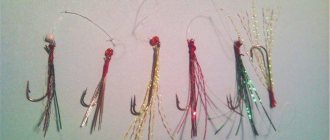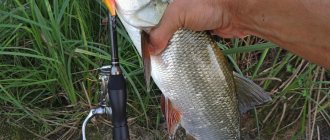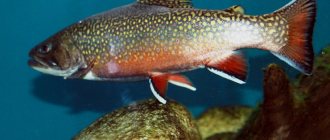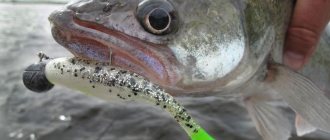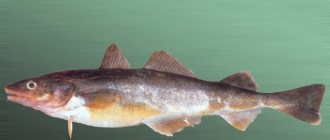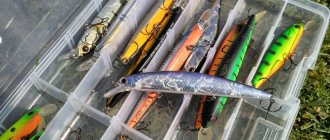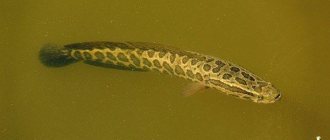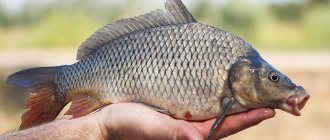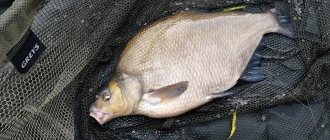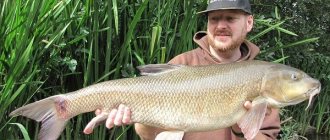Bluefish is one of the few Mediterranean inhabitants that is the object of industrial and sport fishing.
An insatiable predator with a fighting character. Bluefish fishing is dynamic and requires a lot of strength and skill. Unforgettable moments are guaranteed when fishing!
Knowing the character and habits of this predator, you can easily equip your gear; the ability to calculate its location by circling seagulls will ensure a good catch. In what weather you can catch, what to lure, and why bluefish are called “ballerino” in Italy, and “meat grinder” in other countries, you will learn from this article.
Content
- 1. General description of fish
- 2. Distribution and habitats
- 3. Age and size
- 4. Lifestyle
- 4.1 Reproduction - time and characteristics of spawning
- 4.2 Diet - what to eat
- 5.1 Biting calendar - what time of year and day is the best time to bite?
- 5.2 What weather is the best time to bite?
- 5.3 What are the best places to fish?
- 5.4 What gear is best to fish with?
- 5.5 Bait for fishing
- 5.6 What baits and baits to fish with
- Animal attachments:
- Artificial baits
general description
Bluefish is the only representative of its kind. The strong, compressed body is strewn with small scales. Has several dorsal fins, one spiny. The oral cavity is large with strong jaws with one row of sharp teeth-blades.
The back is colored greenish with blue or gray. The sides are light, and the belly is white. The pectoral fins are marked at their base with a dark spot, which is covered at the edges with a yellow border.
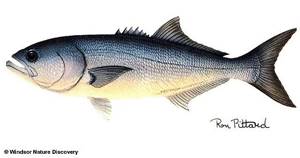
By character: daring, prudent earner. However, outside of hunting, bluefish are not very smart and become easy prey. When meeting a sea hunter, he behaves fussily, which allows him to easily shoot an arrow from an underwater gun. Can easily become prey for larger fish when a school of bluefish is surrounded.
Fishing methods
There are several types of bluefish fishing, let's look at the most effective of them:
- Petty tyrant. The method is relevant when a caught predator is torn from the hook and torn to pieces. This means a school of bluefish is nearby. At this moment, fishing becomes more interesting, since with the help of a tyrant you can catch a large number of large predators.
- Bottom tackle. The method of fishing in sea fishing is not entirely up-to-date and rarely brings a catch. In addition, bluefish mainly live near the surface of the water. But if you run into a school passing by, bottom tackle can lead to success, provided that it is equipped with live bait.
Photo 1. Fishing with a donk.
- Spinning. The most effective way to catch fish. With the help of a spinning rod and the right equipment, they create a natural bait game that attracts a predator.
- Live bait gear. May have different designs. Most often, in sea fishing, a regular fishing line with two leashes and an attached sinker becomes effective.
- Long casting rod. Bluefish fishing is carried out using small pieces of silvery fish, which lure the predator by smell and appearance.
Lifestyle
A schooling fish that lives in the upper layer of the sea surface in open sea areas.
4.1 Reproduction - time and characteristics of spawning
Between the ages of 2 and 4 years, bluefish reach sexual maturity. Females spawn in small portions in the summer (May–August) in the open sea. At such moments, the fish is at depth, escaping the heat. The eggs are small in size, some of which die immediately, while the rest gain strength in the upper parts of the water. After a few days, the fry become independent and begin their hunt.
4.2 Diet - what does bluefish eat?
A representative of predatory Mediterranean fish is indiscriminate in food and consumes all small-sized marine inhabitants. Small bluefish up to 11 cm long lead a predatory lifestyle and feed on small fish, as well as shrimp, small crustaceans, and worms.
Lufari predators have their own hunting tactics, which are as follows. The hunt is lively. Having noticed prey, a flock of bluefish surrounds the prey from all sides and quickly rushes and begins to eat, tearing the prey into pieces, grabbing more and more prey. If someone escapes, he rushes after her, jumping out of the water column, and overtakes the fugitive.
A must watch! This video captures a bloody bluefish dinner. This is a real carnage. A school of fish is driven by a bluefish to the shore, where it mercilessly deals with the fish, leaving behind only clouds of blood in the water and mutilated bodies of fish thrown onto the shore by the waves. Very exciting video.
Predator baits
- Pilkers. In sea fishing, a bait called “jig” or “pilker”, whichever is more convenient, is very popular. The most effective model for catching bluefish is a model that has a narrow cast shape. This is due to the fact that there is a slight bend near the tail of the bait, which in turn gives the bait a natural action. The jig is also used for catching fish in fresh water.
Photo 2. Jig - bait for fishing from a boat.
Photo 3. Spoons for sea fish.
To ensure active bluefish fishing, try to fish early in the morning or late in the evening. In addition to exciting fishing, the underwater inhabitant is popular due to its taste qualities, which cannot be compared with other sea fish.
A bloodthirsty predator from the order Perciformes. Bluefish fishing is one of the most interesting from a sporting point of view, thanks to the unstoppable nature of this type of fish.
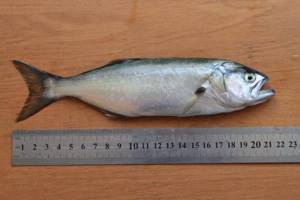
When catching up with its own prey, it is able to jump out of the water and even onto coastal rocks. This gave rise to many myths and opinions about this predator.
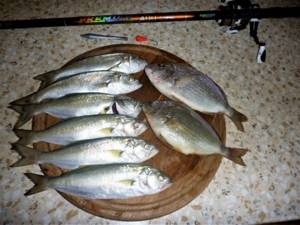
As ferocious as he is in the hunt, he becomes so desperate when he himself acts as the prey, and creates a difficult task for the fisherman.
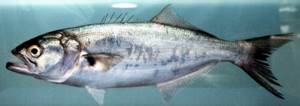
Brief contents of the review:
How, where, when and what to catch this fish
It is better to engage in coastal bluefish fishing in the warm season, since it is during this period that bluefish can be spotted near the seashore.
The presence of a predator can be determined by the number of small fish floating and flying seagulls; it is here that the bluefish will hunt, or the hunt has passed, and the carcasses of torn fish float on the surface.
5.1 Biting calendar - what time of year and day is the best time to bite?
The active fish bite is from dawn to 10 a.m., then after 6 p.m. and until sunset. The bluefish bite occurs throughout the daylight hours.
Seasonal behavior of bluefish.
In winter, bluefish (goombar) migrate to warmer waters, but since Israel is warm, the chance of catching one remains throughout the winter. If there was heavy rain in the spring, then it’s time to go after bluefish; water clouded after heavy rainfall increases the chance of success of its bloody attacks. During the summer heat, fish look for areas with cool water in the open sea; successful fishing is possible in the morning hours. Autumn is the period of the most active bluefish biting, especially during calm periods.
5.2 In what weather does bluefish (goombar) bite best?
There will be a good bite from the shore after a storm in muddy water, when the fish swims to the shoreline for prey. Also, luck will accompany you in stable, dry, non-cold weather and light winds.
5.3 What are the best places to fish?
Fishing for this predator is carried out both from sea transport and from the shore.
5.4 What gear to use for catching bluefish (goombar)
Option1 The simplest option is a spinning rod with a length of 2 to 3 m, equipped with:
- spinning coil;
- fishing line;
- leashes of 2 pcs;
- a sinker weighing from 35 to 50 g, fixed above the leashes at a distance of 50 - 60 cm;
- crochet number 5.
Advice: you need to use a metal leash (as you remember, bluefish have very sharp teeth).
Option 2 Two-handed spinning:
- inertial coil
- main line with a cross section of 0.4 - 0.5 mm;
- tee No. 10-12;
- spinner 0.5 mm thick, 12-15 mm wide, 10-12 cm long.
Option 3 The tackle is a tyrant. Basics:
- hard spinning;
- reel with large line capacity
- fishing line 50 - 80 m (diameter 0, 4 or 0.6 mm).
- column (bet).
Column:
- fishing line 2 m long (0.25 - 0.35 mm in diameter);
- from 5 to 10 leashes (up to 10 cm long) with hooks at a distance from each other from 5 to 25 cm;
- hooks depending on the size of the prey (small No. 5-6, large - 7-10), you can attach doubles or tees;
- a thread or feather of the same color as the hook is attached to the hook (on the back side), foil or polyethylene can be attached;
- make loops at the ends of the column (distance no more than 10 cm);
- a sinker weighing up to 80 g is attached to the lowest loop;
- The fishing line is attached to the upper part using a swivel or carabiner.
Advice: when fishing at night, the distance between the leashes is up to 15 cm, no more.
Option 4 When fishing offshore, it is better to use spinning tackle for long-distance casting with a spinning reel with small rotating spinners of light colors with small sharp 2-3 hooks.
Advice: cast further and lead the lure diagonally towards the shore.
Option 5 For catching small fish, it is better to use gear with a weight of 10 - 40 g. Small hooks are attached on short leashes to a fishing line, at the end of which a light weight is attached.
Option 6 Regular rod. In this case, the hook must correspond to the size of the nozzle and be no more than 15 mm.
Option 7 Fishing with bottom gear equipped with live bait in places with an average current speed can bring some success.
Herringbone equipment One of the manufacturing methods.
An oscillating elongated spoon is attached to the fishing line.
A swivel is attached to its other end.
More leashes with sizes from 10 to 15 cm are tied to the leash at the ends, to which baits in the form of fish are tied (from a metal blank, cut out an ellipse shape 30 - 40 mm long, then bend the resulting product along the axis, slightly bending, tie hooks No. 7 9).
For industrial purposes, bluefish are caught with purse and set nets, trawls and cast nets (fishing method).
5.5 Bait for fishing
Usually not used.
5.6 What baits and baits do bluefish (goombar) bite on?
Animal baits Any small fish or pieces of it.
Artificial baits:
- pilkers;
- octopus;
- elongated wobblers;
- vibrotails;
- twisters;
- spinners.
Advice:
- It is better to use narrow pilker models of silver (cast) color (preference is due to the similarity with fish and good play in the water);
- spinners should be used that are oscillating, heavy, narrow and in light colors, measuring 10 - 20 cm in length and 0.5 - 1.5 cm in width;
- should be similar to garfish or anchovy;
- attach several strong tees to the spinners;
- The use of spoons is recommended in cloudy water in the surf area.
One way to make a spinner:
- Take a stainless metal plate measuring 110 by 12 by 4 mm.
- Give it the appropriate shape by grinding it (anchovy shape).
- The width of the narrow part of the workpiece should be half less than the main one.
- Along the edges, make holes for a tee No. 10-12 on one side and a ring for the fishing line on the other.
5.7 How bluefish (goombar) bite
The bite is sharp, with great force. Poor quality tackle will break if a bluefish weighs 1.5 or 2 kg. It is difficult to hook a predator, since it does not swallow its prey, but tears it apart. If successful, the hook must be sharp, since the fish’s mouth is strong and difficult to damage. After hooking, the bluefish rushes into the depths and with this movement is able to tear off the fragile fishing line. Then the fish flies out of the water and begins violent resistance. It is at such a moment that you can get off the hook. When fishing, the line must be reeled in at intervals of 1-2 turns per second.
When the fish is taken out of the water, the hunter should not relax; the bluefish may bite.
5.8 How to fish correctly? – Basic techniques.
- If you spot a school of bluefish, you should hunt at a distance that allows you to throw a spoon.
- The bait should go straight to the center of the school of predators and should not dive deep into the water.
- It is possible to use the trolling method, which consists of lowering a rod with bait over the side of a moving boat.
- When fishing at shallow depths, fishing should be done in stages.
5.9 The most important points when fishing for bluefish (goombar)
- Observe safety precautions when fishing and removing fish from the hook. The fish has very sharp teeth.
- The gear must be durable.
- Use only metal leashes to prevent bluefish from biting them.
Midnight Experiments
Around midnight, my soul begins to demand experiments, and I assemble an ultralight Black Hole Rimer up to 7 grams, equip it with a Tict M-caro mini 5.0g bombard on the leash, and put a TICT VR Hook with a curved hook on the leash (I’ll say in advance that the hooks showed themselves to be excellent , the fish are cut perfectly, both horse mackerel and weasel (due to prying, the number of idle bites has sharply decreased).
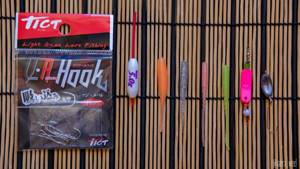
I clamp a 0.25 gram shot on the shank of the hook and hang rubber from Maria Dart's (carrot color) and during the night I slowly catch horse mackerel of different calibers, periodically changing the color and shape of the bait.
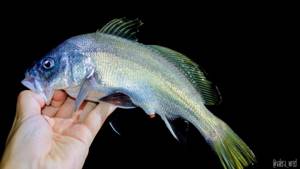
Sometimes I put the ultralight aside and pick up the Nautilus Black Getter light stick up to 15.5 grams. On it I alternate jigs and bottom rigs.
During the night, I had a small croaker fly into a pink paverizom and a stone crab, which stubbornly refused to let go of my hook, clamped in its claw, even after being lifted on board.
In the dark, the guys took a couple of cuckoos (rock perch). I also caught a large amount of horse mackerel, and periodically at night I pecked at a good weasel.
Interesting, unusual, funny facts about this fish
The presence of fish can be understood by floating dismembered carcasses or seagulls circling nearby.
In Italy, this predator is called “ballerino”, due to the manner of jumping out of the water. The Bulgarians call it lafar, and the Turks call it lufer.
Since 1967, an invasion of bluefish from the Mediterranean has been recorded in the Black Sea, which has led to a massive death of mackerel.
The largest catch of bluefish was recorded between 1966 and 1969.
This predator received the nickname “meat grinder”, since after the invasion of the predator, the torn carcasses of various fish are thrown onto the shore and beaches in waves.
Females are very fertile and can hatch up to a million eggs at a time!
